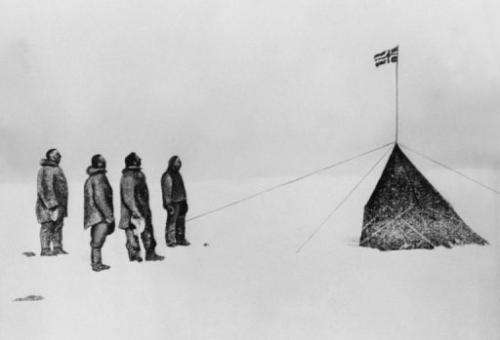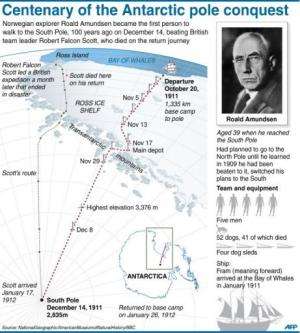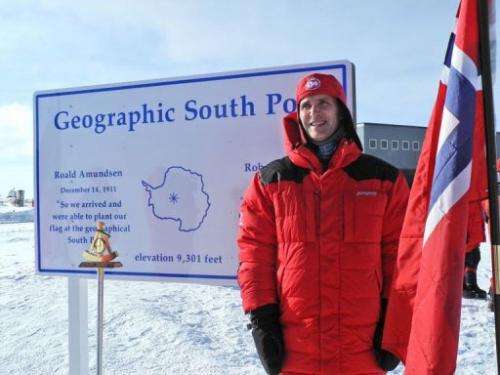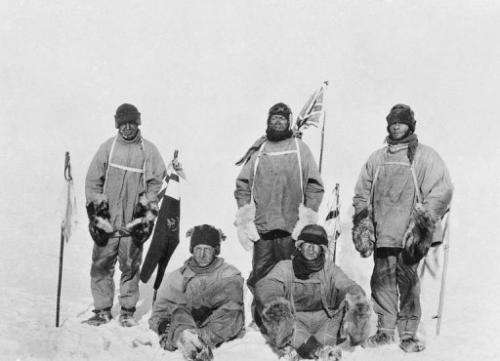Epic race to South Pole remembered on 100th anniversary

One hundred years ago Norwegian explorer Roald Amundsen won the race to the South Pole in a dramatic and ultimately fatal duel with British adventurer Robert Scott that captured the world's attention.
On December 14, 1911, not long before the outbreak of World War I as nationalism was on the rise in Europe, Amundsen and the four members of his team were the first to plant the Norwegian flag at the southernmost tip of the globe.
His victory over the English naval officer is the monumental tale of a pragmatic and wily Scandinavian over the courageous but obdurate gentleman.
With the rest of the world already largely discovered, the two explorers each dreamed of conquering "their" pole: the Norwegian was eyeing the North Pole, the Englishman the South Pole.
"I cannot say -- though I know it would sound much more effective -- that the object of my life was attained," Amundsen later wrote of his heroic feat.
"That would be romancing rather too bare-facedly. I had better be honest and admit straight out that I have never known any man to be placed in such a diametrically opposite position to the goal of his desires as I was at that moment," he confessed.

It was circumstance that led him to Antarctica.
Whilst preparing for an expedition to become the first to reach the North Pole, Amundsen learned that two Americans -- Frederick Cook and Robert Peary -- each claimed to have conquered it. The claims were contested, but enough to convince Amundsen to set his sights on another goal.
In August 1910 he departed for the South Pole. On the sly. It was only in October that Scott read a telegram: "Beg leave inform you proceeding Antarctic. Amundsen".
The British team, for whom conquering the pole was a matter of national prestige, were fired up. The race was on.
The two expeditions arrived in Antarctica in January. The first months were spent testing their equipment and setting up stocks of supplies along the routes they planned to use.
Once the Antarctic winter -- and its accompanying total darkness and glacial temperatures -- passed, Amundsen, who set up his base camp closer to the pole, set off first, on October 20.

During his historic crossing of the Northwest Passage in 1903-1906, he observed the Eskimos at length and learned crucial lessons, including the importance of using sleddogs for transport and caribou skins for keeping warm instead of wool clothing.
The sleds were kept light and their skis -- an area where Norwegians excel -- were planed.
The barrelling sleddogs also served another purpose: of the 52 that started the trek, many ended up on the hungry team's plates.
Meanwhile, the English team arrived with its "heavy artillery". Too heavy, it turned out: in addition to dogs, they had two motorised sleds that soon broke down and ponies that suffered from the inhospitable climate and had to be put down.
Scott's expedition left November 1 but progressed with difficulty. With their ponies gone, the men had to pull the heavy loads themselves in miserable weather conditions.
On January 16, 1912, as they were about to reach their goal, they saw sled tracks in the snow: they were devastated to discover that Amundsen had beaten them to the Pole.
The next day, as they reached the South Pole a good month after their rivals, they saw a tent bearing the Norwegian flag. Inside, a note was addressed to Scott, which Amundsen concluded with the words: "With kind regards I wish you a safe return".
"Great God! This is an awful place," the Englishman wrote in his diary.

His return was an ordeal, with horrendous storms and temperatures falling to minus 42 degrees Celsius (-43 Fahrenheit). His team was weary, and one member succumbed to the cold. Another, his toes ridden with gangrene, left the group to meet certain death.
Caught in a harrowing blizzard, the three survivors were trapped in their tent, frozen and ravenous with their stocks depleted, only 18 kilometers (11 miles) from their closest supply depot.
The last entry in Scott's diary was dated March 29.
"It seems a pity, but I do not think that I can write more. R. Scott. For God's sake look after our people."
That was more than three weeks after Amundsen's return to Tasmania, where he announced his tremendous feat to the world. For Norwegians, who claimed independence from Sweden just a few years earlier, Amundsen was a national hero.
In 1926, Amundsen finally made it to the North Pole in a blimp. He died two years later on a mission to rescue Italian explorer Umberto Nobile.
Scott's body, and those of his two team members, were found in their tent, buried under the snow, in November 1912.
(c) 2011 AFP














